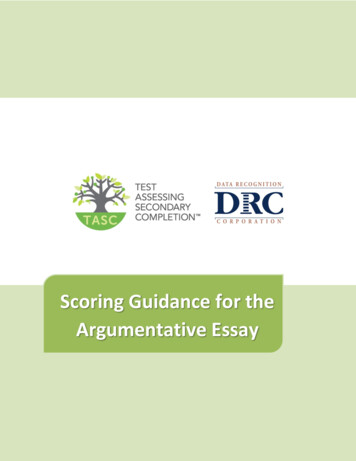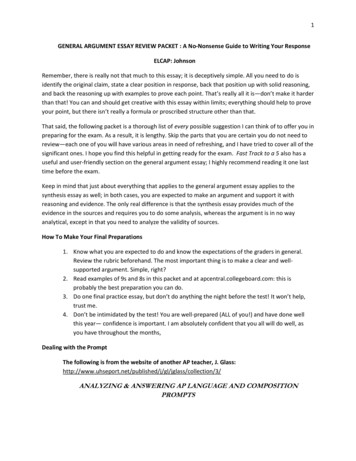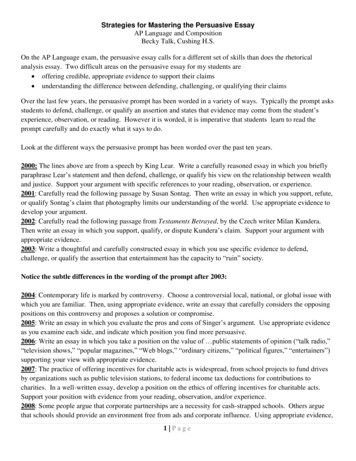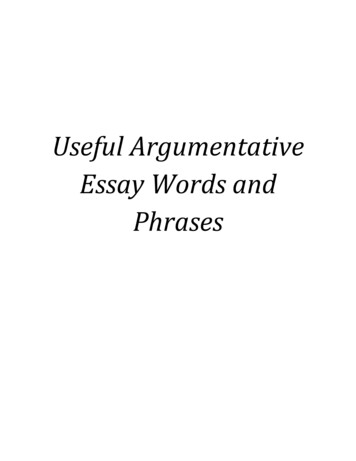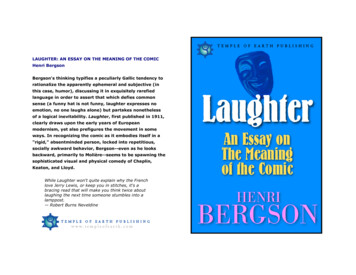
Transcription
LAUGHTER: AN ESSAY ON THE MEANING OF THE COMICHenri BergsonBergson's thinking typifies a peculiarly Gallic tendency torationalize the apparently ephemeral and subjective (inthis case, humor), discussing it in exquisitely rarefiedlanguage in order to assert that which defies commonsense (a funny hat is not funny, laughter expresses noemotion, no one laughs alone) but partakes nonethelessof a logical inevitability. Laughter, first published in 1911,clearly draws upon the early years of Europeanmodernism, yet also prefigures the movement in someways. In recognizing the comic as it embodies itself in a"rigid," absentminded person, locked into repetitious,socially awkward behavior, Bergson--even as he looksbackward, primarily to Molière--seems to be spawning thesophisticated visual and physical comedy of Chaplin,Keaton, and Lloyd.While Laughter won't quite explain why the Frenchlove Jerry Lewis, or keep you in stitches, it's abracing read that will make you think twice aboutlaughing the next time someone stumbles into alamppost.— Robert Burns Neveldine
L A U G H T E R · Henri Bergsonp . 2aLAU GH TER · Henri Bergsonp . 2bTRANSLATORS' PREFACELAUGHTERAN ESSAY ONTHE MEANING OF THE COMICBY HENRI BERGSONMEMBER OF THE INSTITUTE PROFESSOR AT THECOLLEGE DE FRANCEAUTHORISED TRANSLATIONBY CLOUDESLEY BRERETON L. ES L. (PARIS), M.A.(CANTAB) AND FRED ROTHWELL B.A. (LONDON)This work, by Professor Bergson, has been revised in detail by theauthor himself, and the present translation is the only authorisedone. For this ungrudging labour of revision, for the thoroughnesswith which it has been carried out, and for personal sympathy inmany a difficulty of word and phrase, we desire to offer ourgrateful acknowledgment to Professor Bergson. It may be pointedout that the essay on Laughter originally appeared in a series ofthree articles in one of the leading magazines in France, the Revuede Paris. This will account for the relatively simple form of thework and the comparative absence of technical terms. It will alsoexplain why the author has confined himself to exposing andillustrating his novel theory of the comic without entering into adetailed discussion of other explanations already in the field. Henone the less indicates, when discussing sundry examples, why theprincipal theories, to which they have given rise, appear to himinadequate. To quote only a few, one may mention those based oncontrast, exaggeration, and degradation.The book has been highly successful in France, where it is in itsseventh edition. It has been translated into Russian, Polish, andSwedish. German and Hungarian translations are underpreparation. Its success is due partly to the novelty of theexplanation offered of the comic, and partly also to the fact that theauthor incidentally discusses questions of still greater interest andimportance. Thus, one of the best known and most frequentlyquoted passages of the book is that portion of the last chapter inwhich the author outlines a general theory of art.C. B. F. R.
L A U G H T E R · Henri Bergsonp . 3aCONTENTSCHAPTER ITHE COMIC IN GENERAL--THE COMIC ELEMENT IN FORMSAND MOVEMENTS-- EXPANSIVE FORCE OF THE COMICCHAPTER IITHE COMIC ELEMENT IN SITUATIONS AND THE COMICELEMENT IN WORDSCHAPTER IIITHE COMIC IN CHARACTERLAU GH TER · Henri Bergsonp . 3bCHAPTER ITHE COMIC IN GENERAL--THE COMIC ELEMENT IN FORMSAND MOVEMENTS-- EXPANSIVE FORCE OF THE COMIC.What does laughter mean? What is the basal element in thelaughable? What common ground can we find between thegrimace of a merry- andrew, a play upon words, an equivocalsituation in a burlesque and a scene of high comedy? Whatmethod of distillation will yield us invariably the same essencefrom which so many different products borrow either theirobtrusive odour or their delicate perfume? The greatest ofthinkers, from Aristotle downwards, have tackled this littleproblem, which has a knack of baffling every effort, of slippingaway and escaping only to bob up again, a pert challenge flung atphilosophic speculation. Our excuse for attacking the problem inour turn must lie in the fact that we shall not aim at imprisoningthe comic spirit within a definition. We regard it, above all, as aliving thing. However trivial it may be, we shall treat it with therespect due to life. We shall confine ourselves to watching it growand expand. Passing by imperceptible gradations from one form toanother, it will be seen to achieve the strangest metamorphoses.We shall disdain nothing we have seen. Maybe we may gain fromthis prolonged contact, for the matter of that, something moreflexible than an abstract definition,--a practical, intimateacquaintance, such as springs from a long companionship. Andmaybe we may also find that, unintentionally, we have made anacquaintance that is useful. For the comic spirit has a logic of itsown, even in its wildest eccentricities. It has a method in itsmadness. It dreams, I admit, but it conjures up, in its dreams,visions that are at once accepted and understood by the whole of a
L A U G H T E R · Henri Bergsonp . 4asocial group. Can it then fail to throw light for us on the way thathuman imagination works, and more particularly social, collective,and popular imagination? Begotten of real life and akin to art,should it not also have something of its own to tell us about art andlife?At the outset we shall put forward three observations which welook upon as fundamental. They have less bearing on the actuallycomic than on the field within which it must be sought.IThe first point to which attention should be called is that the comicdoes not exist outside the pale of what is strictly HUMAN. Alandscape may be beautiful, charming and sublime, or insignificantand ugly; it will never be laughable. You may laugh at an animal,but only because you have detected in it some human attitude orexpression. You may laugh at a hat, but what you are making funof, in this case, is not the piece of felt or straw, but the shape thatmen have given it,--the human caprice whose mould it hasassumed. It is strange that so important a fact, and such a simpleone too, has not attracted to a greater degree the attention ofphilosophers. Several have defined man as "an animal whichlaughs." They might equally well have defined him as an animalwhich is laughed at; for if any other animal, or some lifeless object,produces the same effect, it is always because of some resemblanceto man, of the stamp he gives it or the use he puts it to.Here I would point out, as a symptom equally worthy of notice, theABSENCE OF FEELING which usually accompanies laughter. Itseems as though the comic could not produce its disturbing effectunless it fell, so to say, on the surface of a soul that is thoroughlycalm and unruffled. Indifference is its natural environment, forLAU GH TER · Henri Bergsonp . 4blaughter has no greater foe than emotion. I do not mean that wecould not laugh at a person who inspires us with pity, for instance,or even with affection, but in such a case we must, for the moment,put our affection out of court and impose silence upon our pity. Ina society composed of pure intelligences there would probably beno more tears, though perhaps there would still be laughter;whereas highly emotional souls, in tune and unison with life, inwhom every event would be sentimentally prolonged and reechoed, would neither know nor understand laughter. Try, for amoment, to become interested in everything that is being said anddone; act, in imagination, with those who act, and feel with thosewho feel; in a word, give your sympathy its widest expansion: asthough at the touch of a fairy wand you will see the flimsiest ofobjects assume importance, and a gloomy hue spread overeverything. Now step aside, look upon life as a disinterestedspectator: many a drama will turn into a comedy. It is enough forus to stop our ears to the sound of music, in a room where dancingis going on, for the dancers at once to appear ridiculous. Howmany human actions would stand a similar test? Should we notsee many of them suddenly pass from grave to gay, on isolatingthem from the accompanying music of sentiment? To produce thewhole of its effect, then, the comic demands something like amomentary anesthesia of the heart. Its appeal is to intelligence,pure and simple.This intelligence, however, must always remain in touch with otherintelligences. And here is the third fact to which attention shouldbe drawn. You would hardly appreciate the comic if you feltyourself isolated from others. Laughter appears to stand in need ofan echo, Listen to it carefully: it is not an articulate, clear, welldefined sound; it is something which would fain be prolonged byreverberating from one to another, something beginning with acrash, to continue in successive rumblings, like thunder in a
L A U G H T E R · Henri Bergsonp . 5amountain. Still, this reverberation cannot go on for ever. It cantravel within as wide a circle as you please: the circle remains, nonethe less, a closed one. Our laughter is always the laughter of agroup. It may, perchance, have happened to you, when seated in arailway carriage or at table d'hote, to hear travellers relating to oneanother stories which must have been comic to them, for theylaughed heartily. Had you been one of their company, you wouldhave laughed like them; but, as you were not, you had no desirewhatever to do so. A man who was once asked why he did notweep at a sermon, when everybody else was shedding tears,replied: "I don't belong to the parish!" What that man thought oftears would be still more true of laughter. However spontaneous itseems, laughter always implies a kind of secret freemasonry, oreven complicity, with other laughers, real or imaginary. How oftenhas it been said that the fuller the theatre, the more uncontrolledthe laughter of the audience! On the other hand, how often has theremark been made that many comic effects are incapable oftranslation from one language to another, because they refer to thecustoms and ideas of a particular social group! It is through notunderstanding the importance of this double fact that the comichas been looked upon as a mere curiosity in which the mind findsamusement, and laughter itself as a strange, isolated phenomenon,without any bearing on the rest of human activity. Hence thosedefinitions which tend to make the comic into an abstract relationbetween ideas: "an intellectual contrast," "a palpable absurdity,"etc.,--definitions which, even were they really suitable to everyform of the comic, would not in the least explain why the comicmakes us laugh. How, indeed, should it come about that thisparticular logical relation, as soon as it is perceived, contracts,expands and shakes our limbs, whilst all other relations leave thebody unaffected? It is not from this point of view that we shallapproach the problem. To understand laughter, we must put itback into its natural environment, which is society, and above allLAU GH TER · Henri Bergsonp . 5bmust we determine the utility of its function, which is a social one.Such, let us say at once, will be the leading idea of all ourinvestigations. Laughter must answer to certain requirements oflife in common. It must have a SOCIAL signification.Let us clearly mark the point towards which our three preliminaryobservations are converging. The comic will come into being, itappears, whenever a group of men concentrate their attention onone of their number, imposing silence on their emotions andcalling into play nothing but their intelligence. What, now, is theparticular point on which their attention will have to beconcentrated, and what will here be the function of intelligence?To reply to these questions will be at once to come to closer gripswith the problem. But here a few examples have becomeindispensable.IIA man, running along the street, stumbles and falls; the passers-byburst out laughing. They would not laugh at him, I imagine, couldthey suppose that the whim had suddenly seized him to sit downon the ground. They laugh because his sitting down is involuntary.Consequently, it is not his sudden change of attitude that raises alaugh, but rather the involuntary element in this change,--hisclumsiness, in fact. Perhaps there was a stone on the road. Heshould have altered his pace or avoided the obstacle. Instead ofthat, through lack of elasticity, through absentmindedness and akind of physical obstinacy, AS A RESULT, IN FACT, OF RIGIDITYOR OF MOMENTUM, the muscles continued to perform the samemovement when the circumstances of the case called for somethingelse. That is the reason of the man's fall, and also of the people'slaughter.
L A U G H T E R · Henri Bergsonp . 6aLAU GH TER · Henri Bergsonp . 6bNow, take the case of a person who attends to the pettyoccupations of his everyday life with mathematical precision. Theobjects around him, however, have all been tampered with by amischievous wag, the result being that when he dips his pen intothe inkstand he draws it out all covered with mud, when he fancieshe is sitting down on a solid chair he finds himself sprawling on thefloor, in a word his actions are all topsy-turvy or mere beating theair, while in every case the effect is invariably one of momentum.Habit has given the impulse: what was wanted was to check themovement or deflect it. He did nothing of the sort, but continuedlike a machine in the same straight line. The victim, then, of apractical joke is in a position similar to that of a runner who falls,-he is comic for the same reason. The laughable element in bothcases consists of a certain MECHANICAL INELASTICITY, justwhere one would expect to find the wide-awake adaptability andthe living pliableness of a human being. The only difference in thetwo cases is that the former happened of itself, whilst the latter wasobtained artificially. In the first instance, the passer-by doesnothing but look on, but in the second the mischievous wagintervenes.to ourselves a certain inborn lack of elasticity of both senses andintelligence, which brings it to pass that we continue to see what isno longer visible, to hear what is no longer audible, to say what isno longer to the point: in short, to adapt ourselves to a past andtherefore imaginary situation, when we ought to be shaping ourconduct in accordance with the reality which is present. This timethe comic will take up its abode in the person himself; it is theperson who will supply it with everything--matter and form, causeand opportunity. Is it then surprising that the absent-mindedindividual--for this is the character we have just been describing-has usually fired the imagination of comic authors? When LaBruyere came across this particular type, he realised, on analysingit, that he had got hold of a recipe for the wholesale manufacture ofcomic effects. As a matter of fact he overdid it, and gave us far toolengthy and detailed a description of Menalque, coming back to hissubject, dwelling and expatiating on it beyond all bounds. The veryfacility of the subject fascinated him. Absentmindedness, indeed,is not perhaps the actual fountain-head of the comic, but surely it iscontiguous to a certain stream of facts and fancies which flowsstraight from the fountain-head. It is situated, so to say, on one ofthe great natural watersheds of laughter.All the same, in both cases the result has been brought about by anexternal circumstance. The comic is therefore accidental: itremains, so to speak, in superficial contact with the person. How isit to penetrate within? The necessary conditions will be fulfilledwhen mechanical rigidity no longer requires for its manifestation astumbling-block which either the hazard of circumstance or humanknavery has set in its way, but extracts by natural processes, fromits own store, an inexhaustible series of opportunities for externallyrevealing its presence. Suppose, then, we imagine a mind alwaysthinking of what it has just done and never of what it is doing, likea song which lags behind its accompaniment. Let us try to pictureNow, the effect of absentmindedness may gather strength in itsturn. There is a general law, the first example of which we havejust encountered, and which we will formulate in the followingterms: when a certain comic effect has its origin in a certain cause,the more natural we regard the cause to be, the more comic shallwe find the effect. Even now we laugh at absentmindedness whenpresented to us as a simple fact. Still more laughable will be theabsentmindedness we have seen springing up and growing beforeour very eyes, with whose origin we are acquainted and whose lifehistory we can reconstruct. To choose a definite example: supposea man has taken to reading nothing but romances of love and
L A U G H T E R · Henri Bergsonp . 7achivalry. Attracted and fascinated by his heroes, his thoughts andintentions gradually turn more and more towards them, till onefine day we find him walking among us like a somnambulist. Hisactions are distractions. But then his distractions can be tracedback to a definite, positive cause. They are no longer cases ofABSENCE of mind, pure and simple; they find their explanation inthe PRESENCE of the individual in quite definite, thoughimaginary, surroundings. Doubtless a fall is always a fall, but it isone thing to tumble into a well because you were looking anywherebut in front of you, it is quite another thing to fall into it becauseyou were intent upon a star. It was certainly a star at which DonQuixote was gazing. How profound is the comic element in theover-romantic, Utopian bent of mind! And yet, if you reintroducethe idea of absentmindedness, which acts as a go-between, you willsee this profound comic element uniting with the most superficialtype. Yes, indeed, these whimsical wild enthusiasts, these madmenwho are yet so strangely reasonable, excite us to laughter byplaying on the same chords within ourselves, by setting in motionthe same inner mechanism, as does the victim of a practical joke orthe passer-by who slips down in the street. They, too, are runnerswho fall and simple souls who are being hoaxed--runners after theideal who stumble over realities, child-like dreamers for whom lifedelights to lie in wait. But, above all, they are past-masters inabsentmindedness, with this superiority over their fellows thattheir absentmindedness is systematic and organised around onecentral idea, and that their mishaps are also quite coherent, thanksto the inexorable logic which reality applies to the correction ofdreams, so that they kindle in those around them, by a series ofcumulative effects, a hilarity capable of unlimited expansion.Now, let us go a little further. Might not certain vices have thesame relation to character that the rigidity of a fixed idea has tointellect? Whether as a moral kink or a crooked twist given to theLAU GH TER · Henri Bergsonp . 7bwill, vice has often the appearance of a curvature of the soul.Doubtless there are vices into which the soul plunges deeply withall its pregnant potency, which it rejuvenates and drags along withit into a moving circle of reincarnations. Those are tragic vices.But the vice capable of making us comic is, on the contrary, thatwhich is brought from without, like a ready-made frame into whichwe are to step. It lends us its own rigidity instead of borrowingfrom us our flexibility. We do not render it more complicated; onthe contrary, it simplifies us. Here, as we shall see later on in theconcluding section of this study, lies the essential differencebetween comedy and drama. A drama, even when portrayingpassions or vices that bear a name, so completely incorporatesthem in the person that their names are forgotten, their generalcharacteristics effaced, and we no longer think of them at all, butrather of the person in whom they are assimilated; hence, the titleof a drama can seldom be anything else than a proper noun. Onthe other hand, many comedies have a common noun as their title:l'Avare, le Joueur, etc. Were you asked to think of a play capable ofbeing called le Jaloux, for instance, you would find that Sganarelleor George Dandin would occur to your mind, but not Othello: leJaloux could only be the title of a comedy. The reason is that,however intimately vice, when comic, is associated with persons, itnone the less retains its simple, independent existence, it remainsthe central character, present though invisible, to which thecharacters in flesh and blood on the stage are attached. At times itdelights in dragging them down with its own weight and makingthem share in its tumbles. More frequently, however, it plays onthem as on an instrument or pulls the strings as though they werepuppets. Look closely: you will find that the art of the comic poetconsists in making us so well acquainted with the particular vice, inintroducing us, the spectators, to such a degree of intimacy with it,that in the end we get hold of some of the strings of the marionettewith which he is playing, and actually work them ourselves; this it
L A U G H T E R · Henri Bergsonp . 8ais that explains part of the pleasure we feel. Here, too, it is really akind of automatism that makes us laugh--an automatism, as wehave already remarked, closely akin to mere absentmindedness.To realise this more fully, it need only be noted that a comiccharacter is generally comic in proportion to his ignorance ofhimself. The comic person is unconscious. As though wearing thering of Gyges with reverse effect, he becomes invisible to himselfwhile remaining visible to all the world. A character in a tragedywill make no change in his conduct because he will know how it isjudged by us; he may continue therein, even though fully consciousof what he is and feeling keenly the horror he inspires in us. But adefect that is ridiculous, as soon as it feels itself to be so,endeavours to modify itself, or at least to appear as though it did.Were Harpagon to see us laugh at his miserliness, I do not say thathe would get rid of it, but he would either show it less or show itdifferently. Indeed, it is in this sense only that laughter "correctsmen's manners." It makes us at once endeavour to appear what weought to be, what some day we shall perhaps end in being.It is unnecessary to carry this analysis any further. From therunner who falls to the simpleton who is hoaxed, from a state ofbeing hoaxed to one of absentmindedness, from absentmindednessto wild enthusiasm, from wild enthusiasm to various distortions ofcharacter and will, we have followed the line of progress alongwhich the comic becomes more and more deeply imbedded in theperson, yet without ceasing, in its subtler manifestations, to recallto us some trace of what we noticed in its grosser forms, an effectof automatism and of inelasticity. Now we can obtain a firstglimpse--a distant one, it is true, and still hazy and confused--ofthe laughable side of human nature and of the ordinary function oflaughter.LAU GH TER · Henri Bergsonp . 8bWhat life and society require of each of us is a constantly alertattention that discerns the outlines of the present situation,together with a certain elasticity of mind and body to enable us toadapt ourselves in consequence. TENSION and ELASTICITY aretwo forces, mutually complementary, which life brings into play. Ifthese two forces are lacking in the body to any considerable extent,we have sickness and infirmity and accidents of every kind. If theyare lacking in the mind, we find every degree of mental deficiency,every variety of insanity. Finally, if they are lacking in thecharacter, we have cases of the gravest inadaptability to social life,which are the sources of misery and at times the causes of crime.Once these elements of inferiority that affect the serious side ofexistence are removed--and they tend to eliminate themselves inwhat has been called the struggle for life--the person can live, andthat in common with other persons. But society asks for somethingmore; it is not satisfied with simply living, it insists on living well.What it now has to dread is that each one of us, content withpaying attention to what affects the essentials of life, will, so far asthe rest is concerned, give way to the easy automatism of acquiredhabits. Another thing it must fear is that the members of whom itis made up, instead of aiming after an increasingly delicateadjustment of wills which will fit more and more perfectly into oneanother, will confine themselves to respecting simply thefundamental conditions of this adjustment: a cut-and-driedagreement among the persons will not satisfy it, it insists on aconstant striving after reciprocal adaptation. Society will thereforebe suspicious of all INELASTICITY of character, of mind and evenof body, because it is the possible sign of a slumbering activity aswell as of an activity with separatist tendencies, that inclines toswerve from the common centre round which society gravitates: inshort, because it is the sign of an eccentricity. And yet, societycannot intervene at this stage by material repression, since it is notaffected in a material fashion. It is confronted with something that
L A U G H T E R · Henri Bergsonp . 9amakes it uneasy, but only as a symptom--scarcely a threat, at thevery most a gesture. A gesture, therefore, will be its reply.Laughter must be something of this kind, a sort of SOCIALGESTURE. By the fear which it inspires, it restrains eccentricity,keeps constantly awake and in mutual contact certain activities of asecondary order which might retire into their shell and go to sleep,and, in short, softens down whatever the surface of the social bodymay retain of mechanical inelasticity. Laughter, then, does notbelong to the province of esthetics alone, since unconsciously (andeven immorally in many particular instances) it pursues autilitarian aim of general improvement. And yet there issomething esthetic about it, since the comic comes into being justwhen society and the individual, freed from the worry of selfpreservation, begin to regard themselves as works of art. In aword, if a circle be drawn round those actions and dispositions-implied in individual or social life--to which their naturalconsequences bring their own penalties, there remains outside thissphere of emotion and struggle--and within a neutral zone in whichman simply exposes himself to man's curiosity--a certain rigidity ofbody, mind and character, that society would still like to get rid ofin order to obtain from its members the greatest possible degree ofelasticity and sociability. This rigidity is the comic, and laughter isits corrective.Still, we must not accept this formula as a definition of the comic.It is suitable only for cases that are elementary, theoretical andperfect, in which the comic is free from all adulteration. Nor do weoffer it, either, as an explanation. We prefer to make it, if you will,the leitmotiv which is to accompany all our explanations. We mustever keep it in mind, though without dwelling on it too much,somewhat as a skilful fencer must think of the discontinuousmovements of the lesson whilst his body is given up to thecontinuity of the fencing-match. We will now endeavour toLAU GH TER · Henri Bergsonp . 9breconstruct the sequence of comic forms, taking up again thethread that leads from the horseplay of a clown up to the mostrefined effects of comedy, following this thread in its oftenunforeseen windings, halting at intervals to look around, andfinally getting back, if possible, to the point at which the thread isdangling and where we shall perhaps find--since the comicoscillates between life and art--the general relation that art bears tolife.IIILet us begin at the simplest point. What is a comic physiognomy?Where does a ridiculous expression of the face come from? Andwhat is, in this case, the distinction between the comic and theugly? Thus stated, the question could scarcely be answered in anyother than an arbitrary fashion. Simple though it may appear, it is,even now, too subtle to allow of a direct attack. We should have tobegin with a definition of ugliness, and then discover what additionthe comic makes to it; now, ugliness is not much easier to analysethan is beauty. However, we will employ an artifice which willoften stand us in good stead. We will exaggerate the problem, so tospeak, by magnifying the effect to the point of making the causevisible. Suppose, then, we intensify ugliness to the point ofdeformity, and study the transition from the deformed to theridiculous.Now, certain deformities undoubtedly possess over others thesorry privilege of causing some persons to laugh; somehunchbacks, for instance, will excite laughter. Without at thispoint entering into useless details, we will simply ask the reader tothink of a number of deformities, and then to divide them into twogroups: on the one hand, those which nature has directed towardsthe ridiculous; and on the other, those which absolutely diverge
L A U G H T E R · Henri Bergsonp . 10aLAUG H TER · Henri Bergsonp . 10bIs it not, then, the case that the hunchback suggests the appearanceof a person who holds himself badly? His back seems to havecontracted an ugly stoop. By a kind of physical obstinacy, byrigidity, in a word, it persists in the habit it has contracted. Try tosee with your eyes alone. Avoid reflection, and above all, do notreason. Abandon all your prepossessions; seek to recapture afresh, direct and primitive impression. The vision you willreacquire will be one of this kind. You will have before you a manbent on cultivating a certain rigid attitude--whose body, if one mayuse the expression, is one vast grin.into this particular cast of features. This is the reason why a face isall the more comic, the more nearly it suggests to us the idea ofsome simple mechanical action in which its personality would forever be absorbed. Some faces seem to be always engaged inweeping, others in laughing or whistling, others, again, in eternallyblowing an imaginary trum
understanding the importance of this double fact that the comic has been looked upon as a mere curiosity in which the mind finds amusement, and laughter itself as a strange, isolated phenomenon, without any bearing on the rest of human activity. Hence those definitio


